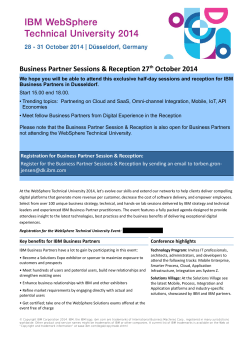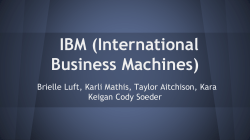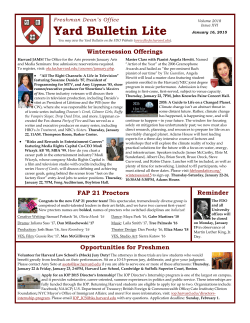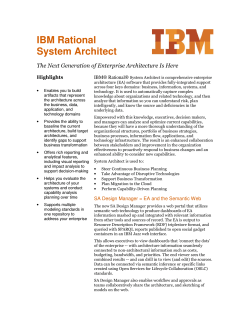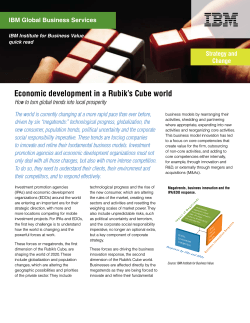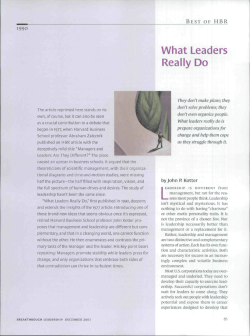
The New Patterns of Innovation by Rashik Parmar,
HBR.ORG JANUARY–FEBRUARY 2014 REPRINT R1401G The New Patterns of Innovation How to use data to drive growth by Rashik Parmar, Ian Mackenzie, David Cohn, and David Gann The New Patterns of Innovation by Rashik Parmar, Ian Mackenzie, David Cohn, and David Gann 2 Harvard Business Review January–February 2014 ILLUSTRATION: JESSICA FORTNER How to use data to drive growth THE NEW PATTERNS OF INNOVATION The search for new business ideas and new business models is hit-ormiss in most corporations, despite the extraordinary pressure on executives to grow their businesses. Management scholars have considered various reasons for this failure. One well-documented explanation: Managers who are skilled at executing clearly defined strategies are ill equipped for out-of-the-box thinking. In addition, when good ideas do emerge, they’re often doomed because the company is organized to support one way of doing business and doesn’t have the processes or metrics to support a new one. That explanation, too, is well supported. Without a doubt, if you tackle business innovation systematically—rather than hoping people will get creative during an “innovation jam” or a special offsite—you improve the odds of success (and decrease the chances you’ll be left staring at a blank sheet of paper). Traditional, tested ways of framing the search for ideas exist, of course. One is competency based: It asks, How can we build on the capabilities and assets that already make us distinctive to enter new businesses and markets? Another is customer focused: What does a close study of customers’ behavior tell us about their tacit, unmet needs? A third addresses changes in the business environment: If we follow “megatrends” or other shifts to their logical conclusion, what future business opportunities will become clear? 4 Harvard Business Review January–February 2014 We’d like to propose a fourth approach. It complements the existing frameworks but focuses on opportunities generated by the explosion in digital information and tools. Simply put, our approach poses this question: How can we create value for customers using data and analytic tools we own or could have access to? Over the past five years, we’ve explored that question with a broad range of IBM clients. In the course of that work, we’ve seen advances in IT facilitate the hunt for new business value in five distinct—but often overlapping—patterns. Those patterns form the basis of our framework. We believe that by examining them methodically, managers in most industries can conceive solid ideas for new businesses. (To learn about the underlying technical trends, see the sidebar “Why Are These Patterns Emerging Now?”) None of the patterns depends on bleeding-edge technology. The first one, in fact, is very familiar: using data that physical objects now generate (or could generate) to improve a product or service or create new business value. Examples of this include smart metering of energy usage that allows utilities to op- COPYRIGHT © 2013 HARVARD BUSINESS SCHOOL PUBLISHING CORPORATION. ALL RIGHTS RESERVED. FOR ARTICLE REPRINTS CALL 800-988-0886 OR 617-783-7500, OR VISIT HBR.ORG Idea in Brief THE CHALLENGE Established companies are notoriously bad at finding new ways to make money, despite the pressure on them to grow. THE ANALYSIS Most companies own or have access to information that could be used to expand old businesses or build new ones. These opportunities exist because of the explosion in digital data, analytic tools, and cloud computing. timize pricing, and devices installed in automobiles that let an insurance company know how safely someone drives. The second pattern is also familiar: digitizing physical assets. Fifteen years ago you could have read this article only in a printed magazine; now you can read it on half a dozen different digital platforms, send it to friends, and say what you think of it via social media. The third pattern is somewhat more recent: combining data within and across industries. (Here we start to enter the realm of “big data.”) An example of this would be a smart-city initiative like the one in Rio de Janeiro, where private utilities, transportation companies, and city agencies consolidate information so that they can deal with natural disasters more effectively. The fourth pattern is trading data; here, a company whose information is valuable to another company sells it, as when a cell phone service identifies traffic jams by seeing where customers in cars are slowed down and shares the information with a navigation-device company. The fifth pattern, codifying a capability, allows a company to take any process in which it is best-in-class— managing travel expenses, for instance—and sell it to other companies, using cloud computing. The new businesses we’ve seen run the gamut from incremental to game-changing. Some simply enhance the current business (they’re sustaining innovations, in Clay Christensen’s terminology). Others are more disruptive: They require a new business model—and often a separate business unit—to support them. Still others evolve or could evolve into platform-based businesses—in which a stable core technology is surrounded by complementary products and services, typically provided by other companies. (Think iTunes and song and video recordings.) In this article we’ll take you through each of the five patterns, providing examples drawn from our clients’ and our own experience. We’ll also provide a set of questions that can help you figure out whether a pattern is relevant to your business. THE SOLUTION Answering a series of questions—from “What data can we access that we’re not capturing now?” to “Can we deliver one of our capabilities as a digital service?”—will help companies find ways to unlock new business value. PATTERN 1: Augmenting Products to Generate Data Because of advances in sensors, wireless communications, and big data, it’s now feasible to gather and crunch enormous amounts of data in a variety of contexts—from wind turbines to kitchen appliances to intelligent scalpels. Those data can be used to improve the design, operation, maintenance, and repair of assets or to enhance how an activity is carried out. Such capabilities, in turn, can become the basis of new services or new business models. A classic example is Rolls-Royce’s engine health management (EHM) capability. In the mid-2000s new sensor technology and data management allowed Rolls-Royce to identify airplane engine problems at an early stage, thereby optimizing maintenance and January–February 2014 Harvard Business Review 5 THE NEW PATTERNS OF INNOVATION Why Are These Patterns Emerging Now? For decades, when we thought about how IT could create value for business, we focused on automating and reducing the cost of operational and management processes. Then the advent of the internet created opportunities to build entirely new business models (witness Google, Amazon, eBay, and the revolution in electronic content distribution). Now a third wave of IT-enabled innovation is being powered by three drivers: THE EXPLOSION IN DIGITAL DATA Digitization is making massive amounts of data readily available. Data about suppliers and partners can be had in near real time, customers are increasingly willing to share all manner of information, and wired objects—the Internet of Things—are coming online in droves. The value of these resources is just beginning to be understood. repair schedules, and to improve engine design. The ability to control costs encouraged the company to adopt a business model in which it retained ownership of the engines and provided maintenance and BETTER TOOLS FOR DATA Our capacity to integrate, analyze, and exploit structured data continues to improve, and our ability to understand and learn from data has been transformed. The humanlike performance of IBM’s Watson on Jeopardy! signaled a major change. Now we know that we can get “the answer” from technology; we just have to decide what to ask. As we learn the right questions, we’ll move from the era of information to the era of insight. A more recent augmented product is SKF’s intelligent bearings, which contain miniaturized, selfpowering sensors that continuously communicate their operating conditions. With this technology, bearings can be monitored in situ, which was previously impossible or impractical. SKF provides the data as an additional service that allows customers to see the extent of any damage within a bearing and take remedial action—for example, adding lubricant or mitigating overloads—well before a failure occurs. Machinery thus becomes more reliable and less vulnerable to downtime. The sensors also measure the load the bearing actually experiences— information that can be used to improve system and bearing design—and can detect problems outside the bearings, such as significant vibrations within the equipment. There’s no reason nonindustrial companies couldn’t take a page from this playbook. Indeed, Progressive Insurance now offers a service called Snapshot, whereby the cost of insurance is based in part on how the customer drives the car. Progressive sends the customer a device that plugs into the car; it records things like mileage, night driving, and heavy braking. PATTERN 2: repairs, charging airlines an all-in fee based on actual hours flown, as part of a “power-by-the-hour” offering. The new data from the sensors also facilitated other services, such as parts inventory management and flight efficiency reporting. One could imagine Rolls-Royce extending this capability further—to engines for cruise ships and turbines—and even building a platform around it. The company could develop an IT-based system with the capacity to handle large volumes of sensorgenerated data, and open it up to third-party applications geared to particular industrial contexts. 6 Harvard Business Review January–February 2014 Digitizing Assets Over the past two decades, the digitization of music, books, and video has famously upended entertainment industries, spawning new models such as iTunes, streaming video services, e-readers, and more. As mobile technologies continue to fuel this trend, more creative businesses are tapping into it and generating their own enhanced services or new business models. Take the International Museum of Women, an innovative nonprofit that hosts internet exhibitions of art created by women around the world. It has an online community of 600,000 annual unique visitors, 10,000 artistic contributors, FOR ARTICLE REPRINTS CALL 800-988-0886 OR 617-783-7500, OR VISIT HBR.ORG BUSINESS IN THE CLOUD For most of history, business transactions occurred in physical space. As business becomes more virtual, its nature changes. For example, increasingly complex processes are now handled by standard software; they can be turned into service offerings through low-cost, high-powered cloud computing. This digitization of business generates opportunities to reduce operating costs and to create new offerings for customers. While each of these trends can create value in its own right, we are now seeing companies learn to combine two or three of them to invent powerful new propositions. 40,000 e-news subscribers, 11,000 Facebook fans, and 7,000 Twitter followers in more than 200 countries worldwide. It can organize and host exhibitions for a fraction of what it costs a traditional museum to borrow, ship, and display works, and it allows visitors to communicate directly with the artists—without ever leaving home. Digitized versions of physical assets are transforming the way people operate in other industries as well. For instance, sophisticated analytic and visualization techniques have improved design in many manufacturing industries, from aerospace and automotive to clothing and furniture. Three-D printing now provides an opportunity to reverse the digitization process and make a physical object from digital representations. (This is how GE builds some turbine parts.) And the digitization of health records, of course, is expected to revolutionize the health care industry, by making the treatment of patients more efficient and appropriate, and slashing hundreds of billions of dollars in costs. Digitization is improving health care in other ways, too: Surgeons are using digital models of the body to increase the accuracy, and reduce the invasiveness, of highly sensitive surgery. The management of digitization itself could be a new business. Many industries need a long-term, secure way to store their digital assets. Those assets might represent aircraft designs, nuclear power plant operations, oil exploration logs, entertainment content, or government records, but the preservation and access-control requirements are essentially the same. Thus, an incumbent that can successfully manage its own data could provide that capability as a service to others, regardless of industry. As more assets become digitized, we expect competitive advantage to shift. Digitization typically slashes distribution costs and makes the ability to move physical inventory efficiently or secure favorable store locations less critical. But you can expect that offering customers more choices and more tailored service will become increasingly important. Going forward, we will see more players explore ways to use the digital nature of the purchase process itself to strengthen customer intimacy and transform the industry yet again. Organizations that can help other companies master this challenge, too, stand to profit. PATTERN 3: Combining Data Within and Across Industries The science of big data, along with new IT standards that allow enhanced data integration, makes it possible to coordinate information across industries or sectors in new ways. Consider the city of Bolzano, in northern Italy, where retired people account for almost a quarter of the population. That puts considJanuary–February 2014 Harvard Business Review 7 THE NEW PATTERNS OF INNOVATION erable strain on social and health services. Working with the city, IBM developed a network of sensors in the home that monitor not only conditions such as temperature, CO2 level, and water usage, but also what constitutes “normal” behavior patterns—for example, regular cooking times. Abnormalities trigger a call to a relative or a friend, who can check that all is well with the senior and alert the appropriate city service if necessary. Behind the scenes, a common IT system links all the relevant agencies—social services, health, and property maintenance—enabling a highly coordinated response. City officials believe that this initiative has lowered assistance and care costs by 30% and allowed many more retirees to stay in their homes, thereby reducing the need to build and run special accommodations for them. Other cities are spearheading cross-sector initiatives as well. The Greater London Authority has set up one that it hopes will inspire brand-new ways of doing business. To manage the roadway congestion caused by a sizable jump in the number of small vans delivering packages from e-retailers to city residents, it has launched the Agile Urban Logistics project. The project combines data on deliveries from the retailers with data on traffic conditions and optimization software. The goal is to encourage the private sector to develop new business models, such as shared-delivery services in specific areas. Similar opportunities can be found in the private sector. While some firms, such as Walmart and Dell, have successfully integrated data across their supply chains, most supply networks are relatively uncoordinated. Advances in IT could help address that problem. In the auto industry, for instance, manufacturing plants that use water to cool machinery need to carefully calibrate water temperatures. Access to reliable data on upstream water temperature could make a meaningful contribution to plant efficiency. Water suppliers could provide such information as a service, which could yield additional revenue. In Germany, a new business is integrating data across one industry—health care—to improve effi8 Harvard Business Review January–February 2014 ciency. Traditionally, medical and dental practices have used a variety of formats (some paper, some electronic) to request payment from insurance companies. The new service collects the information directly from the practices’ IT systems, preserving confidentiality and standardizing and cleaning the data, which it then delivers to each insurance company in its required format. The service allows insurers to automate the payment process and check all billings for fraud. The savings insurers gain as a result more than cover the cost of the service. PATTERN 4: Trading Data The ability to combine disparate data sets allows companies to develop a variety of new offerings for adjacent businesses. Take the recent partnership between Vodafone and TomTom, a provider of satellite navigation devices and services. With its mobile network, Vodafone can identify which of its subscribers are driving, where they are, and how fast they’re moving. Such data can be used to pinpoint traffic jams—information that is extremely valuable to TomTom, which buys it from Vodafone. Cell phone data can also be used to improve transit and traffic management and, we speculate, in morecommercial ways as well—for example, by companies wishing to place context-sensitive advertise- FOR ARTICLE REPRINTS CALL 800-988-0886 OR 617-783-7500, OR VISIT HBR.ORG ments, perhaps for restaurants and stores that are close to a user’s location. An ambitious “open platform” collaboration between the UK’s Meteorological Office, IBM, and Imperial College’s business school and Grantham Institute for Climate Change aims to create a whole new exchange for detailed global weather data. Numerous organizations—including insurers and agencies concerned with responding to natural disasters—need that kind of data. While a great deal of it is available, few standards for it exist, which makes it challenging to share or combine. Furthermore, commonly accepted standards for analytic weather models have not yet been developed. The gaps in both areas constrain the quality of assessments and decision making. The new venture aims to fill those gaps with an online platform that’s open to a wide range of contributors. In a sense it will provide a marketplace for weather knowledge, data, and modeling techniques. The organizations behind it hope it will help galvanize innovative solutions for assessing and managing climate-related risk. (Note that this initiative exemplifies two patterns—trading data and combining data across industries.) better focus the customers’ internal audit processes. IBM now also offers an internally developed accounts receivable system as a service to third parties. Citigroup provides another example. The bank developed models for transaction data to analyze PATTERN 5: Codifying a Distinctive Service Capability Ever since their invention, IT systems have helped automate business processes. Now companies have a practical way to take the processes they’ve perfected, standardize them, and sell them to other parties. Any process that is best-in-class—but not central to a company’s competitive advantage—can thus be turned into a profitable business. Cloud computing has put such opportunities within even closer reach, because it allows companies to easily distribute software, simplify version control, and offer customers “pay as you go” pricing. IBM’s Global Expense Reporting Solutions were originally developed to automate all the steps in the company’s internal travel booking and expensereporting processes. IBM found that, in addition to reducing related administrative costs by 60% to 75%, the systems helped ensure that employees complied with corporate T&E policies, lowering total expense spending by up to 4%. A few years later, realizing that many of its customers would be interested in achieving comparable savings, IBM turned the systems into a service, which it has since sold to organizations worldwide, effectively giving birth to a new business. Analyzing the resulting data flow has allowed IBM to the flow of money in different parts of the financial system, uncovering inefficiencies that hindered its clients’ ability to make effective use of different payment mechanisms. Over a five-year period, those models have been honed into a stream of client services. CitiDirect BE Mobile enables financial institutions and their customers to track the status of payments anytime, anywhere. In the first year it was offered, the system grew to support $11 billion in transactions; now it supports approximately 10 times that amount. In October 2013 the bank launched CitiDirect BE Tablet, which is designed to help C-level executives manage the financial flows of their global companies more effectively. It’s not just IT processes that present opportunities for new value creation. We know of one major UK catalog retailer that has developed an especially efficient and agile system for designing and producing online catalogs. This lets it offer a much bigger range of products while maintaining less than half the stock of competitors. If the company made this industryleading capability available to other retailers as a January–February 2014 Harvard Business Review 9 THE NEW PATTERNS OF INNOVATION service, it could launch a new line of business. That business could in theory be developed into a disruptive platform that third-party retailers could use as a market channel. COMBINING THE PATTERNS The five patterns are a helpful way to structure a conversation about new business ideas—and, as we’ve shown, there are good examples of all five—but actual initiatives often encompass two or three of the patterns. (In fact, as we were writing this article, we were aware that some of our examples could be used to illustrate more than one pattern!) In addition, what begins as a relatively simple extension of an existing business often grows into a whole new business. Take the smart energy meters being rolled out in nearly every developed country, which record the consumption of energy over the course of the day and communicate that information back to the energy provider. These devices started out by augmenting the utilities’ businesses along several dimensions: They made it possible to adopt intraday pricing that reflected demand patterns, to optimize operations and infrastructure usage, and to provide customers with the information needed to manage their own usage. But before long it became clear that the meters created opportunities for altogether new businesses. They could, for instance, gather data on the energy usage patterns of appliances, which could be sold back to their manufacturers, or be used to provide enhanced services to homeowners, such as the feedin of locally produced energy (say, from solar panels). Smart metering could also support a platformbased business, we believe. When the German energy utility company E.ON formed a new business unit focused on a smart meter capability, IBM developed an IT system (software and infrastructure) to support the various activities—data capture, data aggregation, dynamic pricing models—that E.ON Metering needed to undertake. It turns out that the modular design of this system allowed it to be customized for other utility providers as well. (Full disclosure: This new venture is being jointly developed by IBM and E.ON.) And smart meters might even become the technology platform for delivering a wide range of applications to homeowners, from security systems to entertainment systems. GETTING STARTED When we work with clients to uncover new business opportunities, we begin by describing the five pat10 Harvard Business Review January–February 2014 terns, using one or two detailed examples, and then move right to questions designed to inventory the raw material out of which new business value can be carved. The questions seem simple, but answering them requires considerable thought in most cases. • What data do we have? • What data can we access that we are not capturing? • What data could we create from our products or operations? • What helpful data could we get from others? • What data do others have that we could use in a joint initiative? Armed with the answers, the team cycles back through each pattern to explore whether it, or perhaps a modification or combination of patterns, could be applicable in the company’s business context. The questions include: 1. AUGMENTING PRODUCTS • Which of the data relate to our products and their use? • Which do we now keep and which could we start keeping? • What insights could be developed from the data? • How could those insights provide new value to us, our customers, our suppliers, our competitors, or players in another industry? 2. DIGITIZING ASSETS • Which of our assets are either wholly or essentially digital? • How can we use their digital nature to improve or augment their value? • Do we have physical assets that could be turned into digital assets? 3. COMBINING DATA • How might our data be combined with data held by others to create new value? • Could we act as the catalyst for value creation by integrating data held by other players? • Who would benefit from this integration and what business model would make it attractive to us and our collaborators? 4. TRADING DATA • How could our data be structured and analyzed to yield higher-value information? FOR ARTICLE REPRINTS CALL 800-988-0886 OR 617-783-7500, OR VISIT HBR.ORG Success Factors • Is there value in this data to us internally, to our current customers, to potential new customers, or to another industry? The successful initiatives we’ve observed or participated in had four things in common (beyond hygiene factors like a cross-functional team, adequate resources, and top management support). 5. CODIFYING A CAPABILITY • Do we possess a distinctive capability that others would value? • Is there a way to standardize this capability so that it could be broadly useful? • Can we deliver this capability as a digital service? • Who in our industry or other industries would find this attractive? • How could the gathering, management, and analysis of our data help us develop a capability that we could codify? Once we’ve worked our way through the second set of questions, the process looks pretty much as you’d expect it to: The various ideas are collated and prioritized; generally one or two are tapped for further investigation; subgroups are charged with fleshing out the ideas in more detail. They’re asked to develop a scenario in which an idea creates significant new business value and to identify the key assumptions that would need to hold true for that to happen. After a few weeks the team reconvenes to present its work to a senior executive sponsor. FOR SOME years now, information technology has been expanding away from its traditional role of automating and reducing the cost of operational and managerial processes. Of course, IT will continue to serve this function. But it’s becoming a stronger force in the quest for new business opportunities. The faster technology advances, the more opportunities seem to open up. It’s time companies took a structured, systematic approach to examining these advances, carefully considering how IT can enable not only better products and services but also innovative business models and platforms. By thinking through what implications the five patterns hold for their businesses, companies can find ways to engage more fully with the digital economy—and cash in on its promise. HBR Reprint R1401G Rashik Parmar is the president of IBM’s Academy of Technology, Ian Mackenzie is a senior lecturer at Harvard Business School, David Cohn is a research scientist at IBM’s Thomas J. Watson Research Center, and David Gann is vice president of development and innovation at Imperial College London. STRONG TECHNOLOGY PRESENCE INPUTS FROM EXTERNAL PARTIES Having the CIO, the CTO, or whoever has overall responsibility for IT play a major role in the project is critical; it’s even better if that person is the effort’s senior sponsor. This implies, though, that the CIO/CTO role should be focused on business value creation rather than business efficiency, which in turn has implications for the background and skills of the CIO/CTO. The search for innovations often benefits from outside perspectives—whether from customers, suppliers, people in adjacent industries, or IT specialists. Firms that execute ideas most effectively typically involve external parties when scaling up implementation, because it’s a faster way to acquire the capabilities needed to speed offerings to market. MOTIVATED LEADERSHIP EMOTIONAL COMMITMENT If an initiative is disruptive rather than sustaining, it will need a strong leader who can overcome the obstacles that are inevitably set by the incumbent business’s well-established culture. Emerging leaders are often best suited to this role, since they usually have a strong desire to prove themselves and to create something new. Successful initiatives move beyond the intellectual and become an emotional commitment— even a mission—for the people involved. January–February 2014 Harvard Business Review 11
© Copyright 2025

